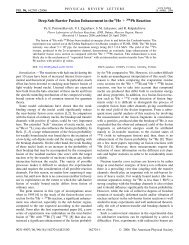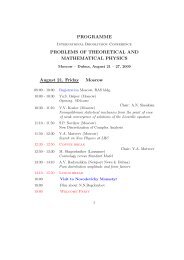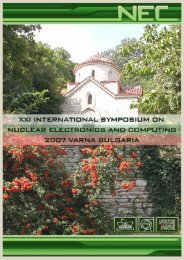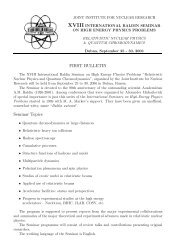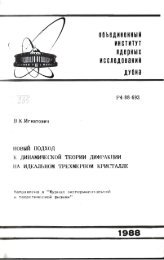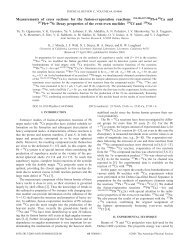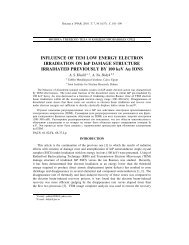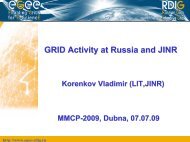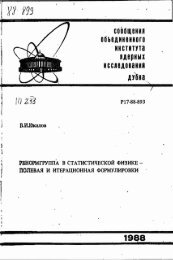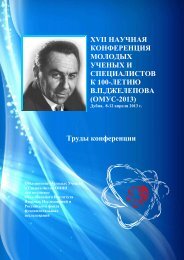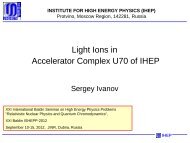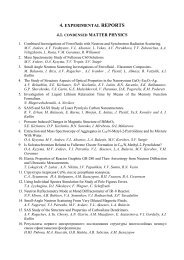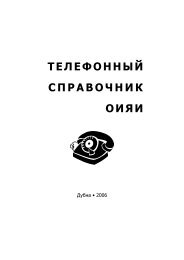Joint Institute for Nuclear Research Relativistic ... - Index of - JINR
Joint Institute for Nuclear Research Relativistic ... - Index of - JINR
Joint Institute for Nuclear Research Relativistic ... - Index of - JINR
You also want an ePaper? Increase the reach of your titles
YUMPU automatically turns print PDFs into web optimized ePapers that Google loves.
which, according to the finite width model [4], are heavy and wide resonances with the<br />
mass M B larger than M 0 ≃ 2.5 GeV and the mean width <strong>of</strong> the <strong>for</strong>m Γ B ≃ Γ 0<br />
[M B<br />
M 0<br />
]1<br />
2<br />
where Γ 0 ∈ [400;600] MeV. Also there are two interesting features <strong>of</strong> QG bags which are<br />
related to the above treatment. Thus, <strong>for</strong> the QG bags one can directly find from (1) the<br />
following value <strong>of</strong> the temperature T + B<br />
,<br />
T + B ≃ Γ 2 0<br />
Q 2 M 0 (1−ξ B ) ≃ 1<br />
(1−ξ B ) ·<br />
{ 11.5 MeV, if Γ0 ≃ 400 MeV,<br />
26 MeV, if Γ 0 ≃ 600 MeV,<br />
(2)<br />
where ξ B ≡ MTh B<br />
M B<br />
denotes the ratio <strong>of</strong> the leading threshold mass MB Th <strong>of</strong> the bag to its<br />
mean mass M B . Clearly <strong>for</strong> different bags the range <strong>of</strong> ξ B value can be between 0 and 1.<br />
However, according to above results the bags with ξ B → 1 should have been essentially<br />
enhanced and sharpened as the ordinary hadrons. Moreover, according to (1) in this case<br />
<strong>for</strong> T ≪ T + B the QG bags should have had a small width ΓN B ≃ T T+ B<br />
ln(2) and, hence,<br />
T + B−T such QG bags should have been stable or, in other words, these bags can be observed!<br />
Our analysis shows that <strong>for</strong> the temperatures T ∈ [80;90] MeV the bags with ξ B → 1<br />
≤ 1<br />
T ln(2)<br />
can have sufficiently long eigen life-time <strong>of</strong> about τ B ∼ 1 ≃ 3.3 ± 0.3 fm/c.<br />
Γ N B<br />
These estimates allow us to make the second important conclusion that an appearance<br />
<strong>of</strong> sharp resonances (baryonic or/and mesonic) with the width in the interval between 50<br />
to 70 MeV at the chemical FO temperatures close to T QGB ≃ 85 ± 5 MeV that have<br />
the mass above 2.5 GeV and that are absent in the tables <strong>of</strong> particle properties would be<br />
a clear signal <strong>of</strong> the QG bag <strong>for</strong>mation. Note that the chemical FO temperatures about<br />
T QGB ≃ 85±5 MeV correspond to √ s NN ∈ [4.5; 5] GeV [1, 2], which is in the range <strong>of</strong> the<br />
Dubna Nuclotron and NICA energies <strong>of</strong> collision. This energy range sets the kinematic<br />
upper limit <strong>for</strong> the QG bag searches, whereas the value <strong>of</strong> minimal mass <strong>of</strong> QG bags,<br />
M 0 ≃ 2.5 GeV, fixes the lower limit <strong>for</strong> the searches.<br />
References<br />
[1] A. Andronic, P. Braun-Munzinger and J. Stachel, Nucl. Phys. A 772, 167 (2006).<br />
[2] D.R. Oliinychenko, K.A. Bugaev and A.S. Sorin, arXiv:1204.0103 [hep-ph].<br />
[3] W. Broniowski, W. Florkowski and L. Y. Glozman, Phys. Rev. D 70, 117503 (2004).<br />
[4] K.A. Bugaev, V.K. Petrov and G.M. Zinovjev, Europhys. Lett. 85, 22002 (2009);<br />
and Phys. Rev. C 79, 054913 (2009).<br />
[5] R. Garcia-Martin, J. R. Pelaez and F. J. Yndurain, Phys. Rev. D 76, 074034 (2007).<br />
34



